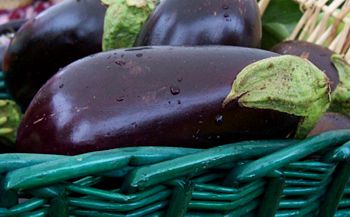Eggplant
Eggplant is the name in American English for Solanum melongena, a perennial cultivated for its edible fruits. In British English it is known by its French name, aubergine.
The eggplant is a member of the nightshade family and a close relative of the potato. It originated in southeastern Asia, and all varieties still require a relatively warm climate (around 80°F) in order to grow.
The classic eggplant fruit is large, dark purple, and egg-shaped. However, there exists a wide variety of sizes, shapes, and colors, including red, yellow, and white.
Eggplant is still eaten throughout southeast Asia. It reached Europe in the 13th century, and is best known in the West from its use in Middle Eastern, Greek and Turkish dishes, such as moussakas, babaganoush, and kebabs. It is also eaten stuffed or fried, baked with tomato and onions, or even raw as in melitzanosalata (Aubergine salad). It is often paired with lamb, another staple of Middle Eastern cuisine.
